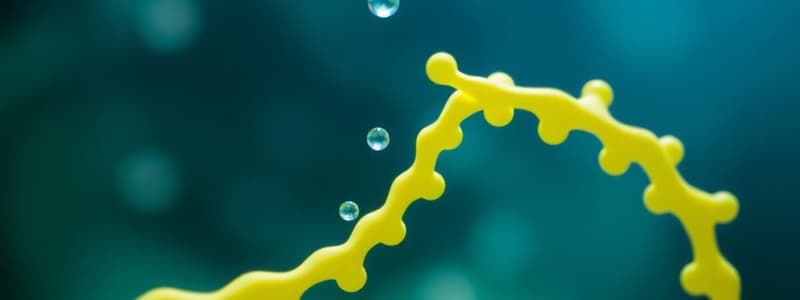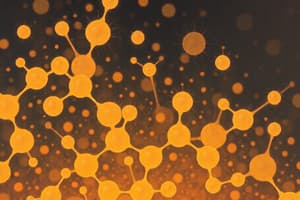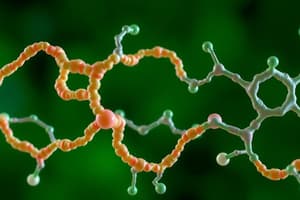Podcast
Questions and Answers
Which of the following is a monosaccharide?
Which of the following is a monosaccharide?
- Fructose (correct)
- Sucrose
- Glycogen
- Lactose
Which is the most common disaccharide found in milk?
Which is the most common disaccharide found in milk?
- Maltose
- Lactose (correct)
- Sucrose
- Glucose
What type of bond links monosaccharides to form disaccharides?
What type of bond links monosaccharides to form disaccharides?
- Phosphodiester bond
- Glycosidic bond (correct)
- Peptide bond
- Hydrogen bond
Starch is composed of which two polysaccharides?
Starch is composed of which two polysaccharides?
Which of the following is an example of a storage carbohydrate in animals?
Which of the following is an example of a storage carbohydrate in animals?
The major structural carbohydrate in plants is:
The major structural carbohydrate in plants is:
Which of the following is a reducing sugar?
Which of the following is a reducing sugar?
Which enzyme breaks down starch into maltose?
Which enzyme breaks down starch into maltose?
Which monosaccharide is an aldose?
Which monosaccharide is an aldose?
Chitin is a polysaccharide found in:
Chitin is a polysaccharide found in:
The main function of glycogen is:
The main function of glycogen is:
Which of the following is a pentose sugar?
Which of the following is a pentose sugar?
Which carbohydrate cannot be digested by humans?
Which carbohydrate cannot be digested by humans?
Which of the following polysaccharides is highly branched?
Which of the following polysaccharides is highly branched?
Lactose is composed of which two monosaccharides?
Lactose is composed of which two monosaccharides?
The primary role of carbohydrates in the body is to:
The primary role of carbohydrates in the body is to:
Which sugar is the main form of carbohydrate found in blood?
Which sugar is the main form of carbohydrate found in blood?
Which of the following is a component of bacterial cell walls?
Which of the following is a component of bacterial cell walls?
Which is the major carbohydrate used for energy in plants?
Which is the major carbohydrate used for energy in plants?
Sucrose is a disaccharide composed of:
Sucrose is a disaccharide composed of:
What type of bond connects amino acids in proteins?
What type of bond connects amino acids in proteins?
Which of the following is an essential amino acid?
Which of the following is an essential amino acid?
What is the primary structure of a protein?
What is the primary structure of a protein?
Hemoglobin is an example of a protein with:
Hemoglobin is an example of a protein with:
Which of the following stabilizes the secondary structure of proteins?
Which of the following stabilizes the secondary structure of proteins?
Which protein is responsible for oxygen transport in blood?
Which protein is responsible for oxygen transport in blood?
The tertiary structure of a protein is primarily determined by:
The tertiary structure of a protein is primarily determined by:
What is the role of enzymes in the body?
What is the role of enzymes in the body?
Which of the following is a fibrous protein?
Which of the following is a fibrous protein?
Proteins are synthesized by:
Proteins are synthesized by:
Which of the following amino acids contains sulfur?
Which of the following amino acids contains sulfur?
A denatured protein has lost its:
A denatured protein has lost its:
What type of interaction is primarily responsible for stabilizing alpha-helices in proteins?
What type of interaction is primarily responsible for stabilizing alpha-helices in proteins?
Which protein is primarily involved in muscle contraction?
Which protein is primarily involved in muscle contraction?
Which of the following is not a function of proteins?
Which of the following is not a function of proteins?
Which bond forms between the carboxyl group of one amino acid and the amino group of another?
Which bond forms between the carboxyl group of one amino acid and the amino group of another?
Which level of protein structure involves multiple polypeptide chains?
Which level of protein structure involves multiple polypeptide chains?
Which protein is found in high concentrations in hair, nails, and skin?
Which protein is found in high concentrations in hair, nails, and skin?
Which process describes the formation of a peptide bond between amino acids?
Which process describes the formation of a peptide bond between amino acids?
A protein's function is most directly determined by its:
A protein's function is most directly determined by its:
The R group of an amino acid determines its:
The R group of an amino acid determines its:
What kind of protein structure do beta-sheets represent?
What kind of protein structure do beta-sheets represent?
Which protein is involved in blood clotting?
Which protein is involved in blood clotting?
Denaturation of a protein affects its:
Denaturation of a protein affects its:
Which molecule is commonly known as the energy currency of the cell?
Which molecule is commonly known as the energy currency of the cell?
Amino acids that cannot be synthesized by the human body are called:
Amino acids that cannot be synthesized by the human body are called:
What is the main structural protein in the extracellular matrix of animal tissues?
What is the main structural protein in the extracellular matrix of animal tissues?
Which enzyme is responsible for breaking down proteins during digestion?
Which enzyme is responsible for breaking down proteins during digestion?
Flashcards
What is a monosaccharide?
What is a monosaccharide?
A simple sugar that cannot be broken down further into smaller sugars. Examples are glucose, fructose, and galactose.
What is a disaccharide?
What is a disaccharide?
A sugar molecule formed by the combination of two monosaccharide units. Common examples include sucrose (table sugar), lactose (milk sugar), and maltose (malt sugar).
What type of bond links monosaccharides?
What type of bond links monosaccharides?
A type of covalent bond that links monosaccharides together to form disaccharides and polysaccharides. It involves the removal of a water molecule.
What is a polysaccharide?
What is a polysaccharide?
Signup and view all the flashcards
What is glycogen?
What is glycogen?
Signup and view all the flashcards
What is cellulose?
What is cellulose?
Signup and view all the flashcards
What is a reducing sugar?
What is a reducing sugar?
Signup and view all the flashcards
What is amylase?
What is amylase?
Signup and view all the flashcards
What is an aldose?
What is an aldose?
Signup and view all the flashcards
What is chitin?
What is chitin?
Signup and view all the flashcards
What is a pentose?
What is a pentose?
Signup and view all the flashcards
What is a peptide bond?
What is a peptide bond?
Signup and view all the flashcards
What is the primary structure of a protein?
What is the primary structure of a protein?
Signup and view all the flashcards
What is the tertiary structure of a protein?
What is the tertiary structure of a protein?
Signup and view all the flashcards
What is the quaternary structure of a protein?
What is the quaternary structure of a protein?
Signup and view all the flashcards
What is hemoglobin?
What is hemoglobin?
Signup and view all the flashcards
What is collagen?
What is collagen?
Signup and view all the flashcards
What is an essential amino acid?
What is an essential amino acid?
Signup and view all the flashcards
What is an enzyme?
What is an enzyme?
Signup and view all the flashcards
What is keratin?
What is keratin?
Signup and view all the flashcards
What is a fibrous protein?
What is a fibrous protein?
Signup and view all the flashcards
What is protein synthesis?
What is protein synthesis?
Signup and view all the flashcards
What is protein digestion?
What is protein digestion?
Signup and view all the flashcards
What is protein denaturation?
What is protein denaturation?
Signup and view all the flashcards
What is protein assembly?
What is protein assembly?
Signup and view all the flashcards
What is condensation?
What is condensation?
Signup and view all the flashcards
What is actin?
What is actin?
Signup and view all the flashcards
What is myoglobin?
What is myoglobin?
Signup and view all the flashcards
What is fibrinogen?
What is fibrinogen?
Signup and view all the flashcards
How does a protein's shape relate to its function?
How does a protein's shape relate to its function?
Signup and view all the flashcards
What is the R group of an amino acid?
What is the R group of an amino acid?
Signup and view all the flashcards
What is a beta-sheet?
What is a beta-sheet?
Signup and view all the flashcards
What is ATP?
What is ATP?
Signup and view all the flashcards
What are essential amino acids?
What are essential amino acids?
Signup and view all the flashcards
What is elastin?
What is elastin?
Signup and view all the flashcards
What is pepsin?
What is pepsin?
Signup and view all the flashcards
Study Notes
Carbohydrates
- Monosaccharides: Fructose is a monosaccharide
- Disaccharides: Lactose is the most common disaccharide in milk
- Disaccharide bond: Glycosidic bonds link monosaccharides to form disaccharides
- Polysaccharides: Starch is composed of amylose and amylopectin
- Storage carbohydrate (animals): Glycogen
- Structural carbohydrate (plants): Cellulose
- Reducing sugar: Glucose
- Enzyme for starch breakdown: Amylase breaks down starch into maltose
Carbohydrates (additional)
- Aldose: Glucose is an aldose
- Polysaccharide in fungi walls: Chitin
- Energy storage in animals: Glycogen
- Pentose sugar: Ribose
- Carbohydrate indigestible by humans: Cellulose
- Highly branched polysaccharide: Glycogen
- Lactose components: Glucose and galactose
- Energy source in plants: Starch
- Sucrose components: Glucose and fructose
Proteins
- Amino acid bond: Peptide bonds connect amino acids in proteins
- Essential amino acid: Lysine
- Protein structure: Sequence of amino acids (Primary structure)
- Protein shape: 3D shape crucial for protein function
- Protein folding: Interactions between amino acid side chains (R groups) lead to protein folding
- Secondary structure: Stabilized by hydrogen bonds
- Tertiary structure: 3D structure, determined by interactions between amino acid side chains
- Quaternary structure: Multiple polypeptide chains
- Protein responsible for oxygen transport: Hemoglobin
- Enzyme for protein digestion: Pepsin
- Protein in muscle contraction: Actin
- Protein in blood clotting: Fibrinogen
- Protein in hair, nails and skin: Collagen
- Protein synthesis location: Ribosomes
- Sulfur-containing amino acid: Methionine
Other
- Energy currency of the cell: ATP
- Amino acids not synthesized by human body: Essential amino acids
- Structural protein in animal tissues: Collagen
- Bond forming amino acids: Peptide bond
Studying That Suits You
Use AI to generate personalized quizzes and flashcards to suit your learning preferences.
Related Documents
Description
Test your knowledge on the basics of carbohydrates and proteins. This quiz covers monomers, bonds, classifications, and functions of carbohydrates, as well as the structure and formation of proteins. Perfect for students looking to reinforce their understanding of these essential macromolecules.




